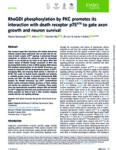January 11th, 2017 UPDATE 2017-05-29: The positions have been filled.
Postdoc/Research Fellows are being recruited to our NUS laboratory. We are seeking talented, innovative and enthusiastic researchers with a PhD awarded within the last 5 years.
Cell signaling
The successful candidate will have a strong background in studies of cell signaling using molecular, cellular and biochemical methods. The aim of the project is to elucidate mechanisms of differential signaling by death receptors through the NFkB, c-Jun kinase and RhoA GTPase pathways, among others, taking advantage of recent knowledge on structure-function relationships in this class of receptors as well as a large collection of mutants developed at our laboratory. Strong expertise in cell and molecular biology techniques is essential. Additional expertise in live cell imaging will also be an asset to the project.
Drug Discovery
The successful candidate will have a strong background in studies of intracellular signaling involving biochemical assays, gene reporter assays and microscopy techniques. The aim of the project is the identification and characterisation of novel small molecule modulators (inhibitors and activators) of growth factor receptor signaling taking advantage of a novel screening strategy developed in the laboratory based on recent knowledge on the mechanisms of activation and downstream signal propagation of death receptors and receptors of the TGFb superfamily. Strong expertise in cell and molecular biology techniques is essential. Additional expertise in small molecule screening and/or chemistry will also be an asset to the project.
Applications, including CV, list of publications and statement of future interests should be sent to Prof. Carlos Ibanez  . Applicants should arrange to have at least two confidential letters of reference sent independently by referees to this email address. . Applicants should arrange to have at least two confidential letters of reference sent independently by referees to this email address.
Funding is available for an initial period of 2 to 3 years, starting any time during 2017.
Deadline for the application is March 07, 2017.
January 10th, 2017 In this new paper, we show how the GFRα1 receptor regulates Purkinje cell migration independently of GDNF or RET, by limiting the function of NCAM. The paper has just been published in Cell Reports.
During embryonic development of the cerebellum, Purkinje cells (PCs) migrate away from the ventricular zone to form the PC plate. The mechanisms that regulate PC migration are incompletely understood. Here, we report that the neurotrophic receptor GFRα1 is transiently expressed in developing PCs and loss of GFRα1 delays PC migration. Neither GDNF nor RET, the canonical GFRα1 ligand and co-receptor, respectively, contribute to this process. Instead, we found that the neural cell adhesion molecule NCAM is co-expressed and directly interacts with GFRα1 in embryonic PCs. Genetic reduction of NCAM expression enhances wild-type PC migration and restores migration in Gfra1 mutants, indicating that NCAM restricts PC migration in the embryonic cerebellum. In vitro experiments indicated that GFRα1 can function both in cis and trans to counteract NCAM and promote PC migration. Collectively, our studies show that GFRα1 contributes to PC migration by limiting NCAM function.
Read the full paper HERE.
December 10th, 2016 In our latest paper, we show how thalamo-cortical axons regulate the radial dispersion of neocortical GABAergic interneurons. The paper has just been published in eLife.
Neocortical GABAergic interneuron migration and thalamo-cortical axon (TCA) pathfinding follow similar trajectories and timing, suggesting they may be interdependent. The mechanisms that regulate the radial dispersion of neocortical interneurons are incompletely understood. In this new study we report that disruption of TCA innervation, or TCA-derived glutamate, affected the laminar distribution of GABAergic interneurons in mouse neocortex, resulting in abnormal accumulation in deep layers of interneurons that failed to switch from tangential to radial orientation. Expression of the KCC2 cotransporter was elevated in interneurons of denervated cortex, and KCC2 deletion restored normal interneuron lamination in the absence of TCAs. Disruption of interneuron NMDA receptors or pharmacological inhibition of calpain also led to increased KCC2 expression and defective radial dispersion of interneurons. Thus, although TCAs are not required to guide the tangential migration of GABAergic interneurons, they provide crucial signals that restrict interneuron KCC2 levels, allowing coordinated neocortical invasion of TCAs and interneurons.
Read the full paper HERE. (Supplemental information 31.6MB)
August 15th, 2016 Shuhailah Salim holds a Bachelor in Science from Nanyang Technological University. She did a research internship at the Institute of Molecular and Cell biology (IMCB, A*STAR). She joins our NUS group to support biochemical, tissue culture and drug screening studies.
New Chih Sheng holds a Bachelor in Science from the University of Toronto. He did a research internship at the Institute of Molecular and Cell biology (IMCB, A*STAR). She joins our NUS group to support our metabolism research projects with mouse genotyping and tissue culture.
August 1st, 2016 Yi Chenju holds a Bachelor in Clinical Medicine from Tongji Medical College, Huazhong University of Science and Technology, China, a PhD in Neurology form the same institution and an MD from the Institute of Brain Research, University of Tübingen, Germany. She performed postdoctoral studies at College de France under the direction of Drs. Christian Gaume and Annette Koulakoff. Chenju is joining the NUS group to lead investigations on p75NTR-mediated mechanisms of neurodegeneration in mouse models of Alzheimer’s disease.
May 18th, 2016 In our latest paper, we show how dimers of the p75NTR neurotrophin receptor are indipensable for p75NTR-mediated cell death in the central nervous system. The paper has justg been published in the Journal of Neuroscience.
The oligomeric state and activation mechanism that enable p75 NTR to mediate these effects have recently been called into question. In this new study, we have investigated mutant mice lacking the p75NTR death domain (DD) or a highly conserved transmembrane (TM) cysteine residue (Cys 259) implicated in receptor dimerization and activation. Neuronal death induced by proneurotrophins or epileptic seizures was assessed and compared with responses in p75NTR knock-out mice and wild-type animals. Proneurotrophins induced apoptosis of culturedhippocampalandcorticalneuronsfromwild-typemice,butmutantneuronslackingp75NTR,onlythep75NTR DD,orjustCys259 were all equally resistant to proneurotrophin-induced neuronal death. Homo-FRET anisotropy experiments demonstrated that both NGF and proNGF induce conformational changes in p75 NTR that are dependent on the TM cysteine. In vivo, neuronal death induced by pilocarpine-mediated seizures was significantly reduced in the hippocampus and somatosensory, piriform, and entorhinal cortices of all three strains of p75 NTR mutant mice. Interestingly, the levels of protection observed in mice lacking the DD or only Cys 259 were identical to those of p75 NTR knock-out mice even though the Cys 259 mutant differed from the wild-type receptor in only one amino acid residue. We conclude that,bothinvitroandinvivo,neuronaldeathinducedbyp75NTR requirestheDDandTMCys259,supportingthephysiological relevance of DD signaling by disulfide-linked dimers of p75NTR in the CNS.
Read the full paper HERE.
April 20th, 2016 UPDATE 01-06-2016: The position has been filled.
A Research Assistant/Associate is currently being recruited to our laboratory in the Centre for Life Sciences, National University of Singapore, Kent Ridge campus.
The successful candidate will be a dynamic, service-minded person, with a solid research background in molecular biology, tissue culture, histological techniques and/or mouse genetics methods. He/she will have a strong presence in the laboratory by assisting the group with experimental lab routines as well as conducting research together with other lab members or independently, including:
maintenance of mouse colonies and genotypinghistological studiesmolecular biology studiestissue culture studies
Applications including CV and names plus email addresses of three referees should be sent by email to Prof. Carlos Ibanez 
Deadline: MAY 21st, 2016
February 10th, 2016 UPDATE 2016-04-11: The position has been filled.
As part of a University-wide initiative on mechanisms of neuronal and synaptic �injury in aging and neurodegenerative diseases, we are seeking talented and �enthusiastic individuals to join our laboratory.
Carlos Ibanez is Professor at the Department of Physiology, Yong Loo Lin School �of Medicine, National Univeristy of Singapore, and Department of Neuroscience, �Karolinska Institute, Stockholm, Sweden.
Under the direction of Prof. Carlos Ibanez, this project will focus on studies of the role of neurotrophin signaling in neurodegenerative diseases, with afocus on Alzheimer’s disease and dementias. This is an exciting opportunity for individuals who have �received a doctoral degree within the past five years and with a strong background in cellular neurobiology. Other requirements include i) experience on mouse models, i i) experience in neurohistological methods, and iii) ability to work independently with precision and good organizational skills. Located on the Medical School campus of the National University of Singapore, there �is close integration among the core laboratories of this strategic initiative. This �provides for an exciting environment to pursue neuroscience research and a great �opportunity in one of the most developed and exciting countries in the region.
Applications including CV and names plus email addresses of three referees should �be sent by email to Prof. Carlos Ibanez  . .
Deadline: MARCH 31, 2016
February 9th, 2016 A targeted effort to identify novel neurotrophic factors for midbrain dopaminergic neurons resulted in the isolation of GDNF (glial cell line-derived neurotrophic factor) from the supernatant of a rat glial cell line in 1993. Over two decades and 1200 papers later, the GDNF ligand family and their different receptor systems are now recognized as one of the major neurotrophic networks in the nervous system, important for the devel- opment, maintenance and function of a variety of neurons and glial cells. The many ways in which the four mem- bers of the GDNF ligand family can signal and function allow these factors to take part in the control of multiple types of processes, from neuronal survival to axon guidance and synapse formation in the developing nervous system, to synaptic function and regenerative responses in the adult. In this review, recently published in Neurobiology Of Disease, basic aspects of GDNF signaling mechanisms and receptor systems are first summarized followed by a review of current knowledge on the physiology of GDNF activities in the central nervous system, with an eye to its relevance for neurodegenerative and neuropsychiatric diseases. Read the full paper HERE.
January 20th, 2016 The National Medical Research Council of Singapore has awarded a Collaborative Basic Research Grant (CBRG) to Carlos Ibanez for investigations into novel pathways controlling metabolic functions in adipose tissue. The award includes collaborative projects with Han Weiping, from the Singapore Bioimaging Consortium at ASTAR, Neerja Karnani, from the Singapore Institue for Clinical Sciences, and Asim Shabbir, from the National University Hospital of Singapore.
|
|
|
Warning: Undefined array key "full_width_footer" in /customers/2/6/6/carlosibanezlab.se/httpd.www/NUS/wp-content/themes/atahualpa_3723/footer.php on line 93
 . Applicants should arrange to have at least two confidential letters of reference sent independently by referees to this email address.
. Applicants should arrange to have at least two confidential letters of reference sent independently by referees to this email address.


